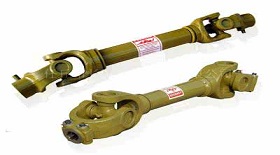Classification of the universal joint
The universal joint is divided into quasi constant speed universal joint and constant speed universal thrust ball bearing section
Quasi-constant speed universal joint
Common quasi constant speed universal joint has two kinds of double-coupling and three-pin shaft, and their working principle and double cross shaft universal joint to achieve constant speed transmission principle is the same. The double universal joint is a set of constant speed transmission device which reduces the length of the transmission shaft to the minimum. The double universal joint is equivalent to the transmission shaft and the universal joint fork with both ends on the same plane. When the angle between the output shaft and the inquiry shaft of the transmission model is small, the angular velocity of the two shafts is close to the same, and the intersection point of the two shafts on the arc is very close to the above-mentioned center vertical line, so the difference between the alpha-aligning roller bearing 1 and alpha-2 is very small, so the double-connection universal joint is called quasi-constant speed universal joint.
Constant velocity universal joint
Disadvantages: pressure assembly, steel ball and curved groove, large unit pressure. Disassembly and assembly is not convenient and wear is fast. Only two steel balls transmit force, while the other two balls transfer force.
Three pin shaft universal bearing section
Advantages: it allows the two adjacent axes to have a large angle of intersection, up to 45&. In the steering drive axle, the automobile model inquiry vehicle can get smaller turning radius and improve the vehicle mobility.
Disadvantages: larger space. It is evolved from dual universal joints.



